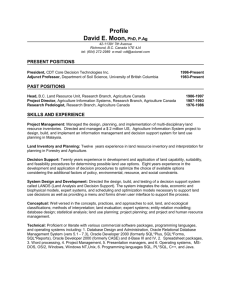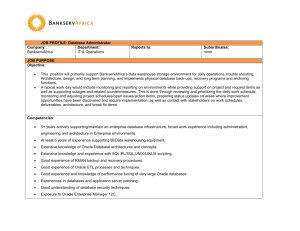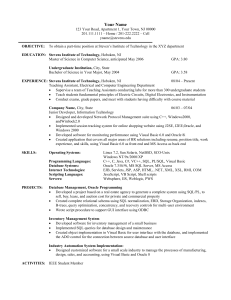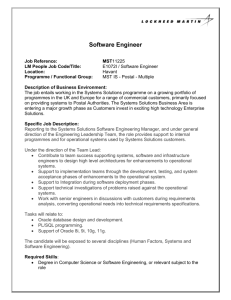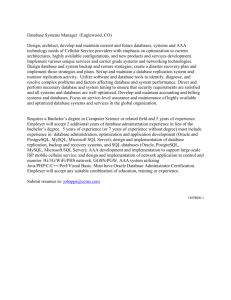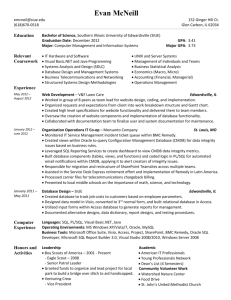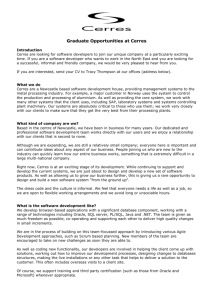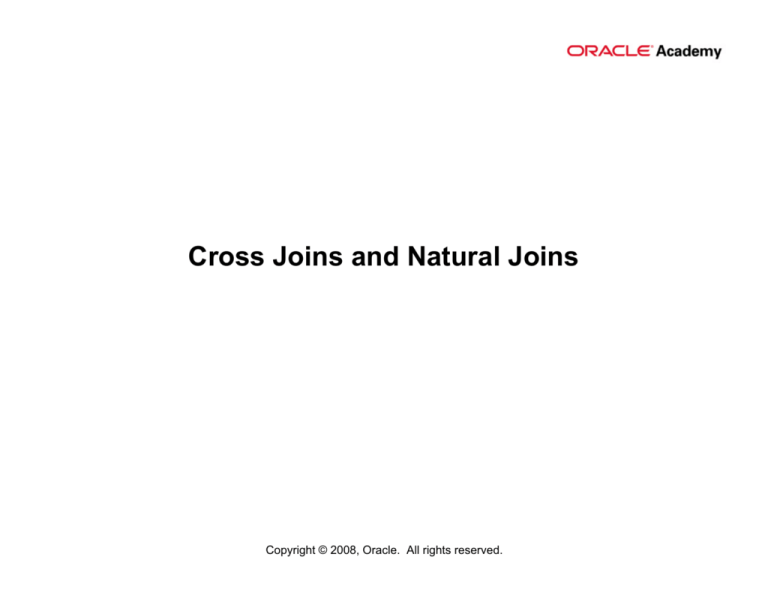
Cross Joins and Natural Joins
Copyright © 2008, Oracle. All rights reserved.
Cross Joins and Natural Joins
What Will I Learn?
In this lesson, you will learn to:
•
•
•
•
•
Compose and execute a natural join using
ANSI-99 SQL join syntax
Create a cross join using ANSI-99 SQL join
syntax
Define the relationship between a cross join
and a Cartesian product
Define the relationship between a natural join
and an equijoin
Explain why it is important to have a standard
for SQL as defined by ANSI
Copyright © 2008, Oracle. All rights reserved.
2
Cross Joins and Natural Joins
Why Learn It?
The join statements you learned in the last
few lessons have a corresponding statement
when using ANSI/ISO SQL: 1999 syntax.
Being able to use both kinds of joins
effectively is the responsibility of any person
using SQL.
You may join a project someday when a
programmer before you used only ANSI/ISO
SQL: 1999. What would you do if you knew
only the Oracle proprietary methods? How
would you debug their code?
Copyright © 2008, Oracle. All rights reserved.
3
Cross Joins and Natural Joins
Tell Me / Show Me
ANSI
ANSI stands for American National Standards Institute. Founded
in 1918, ANSI is a private, non-profit organization that
administers and coordinates the U.S. voluntary standardization
and conformity assessment system.
The Institute's mission is to enhance both the global
competitiveness of U.S. business and the U.S. quality of life by
promoting and facilitating voluntary consensus standards and
conformity assessment systems, and safeguarding their integrity.
Reference: http://www.ansi.org/default.aspx
Copyright © 2008, Oracle. All rights reserved.
4
Cross Joins and Natural Joins
Tell Me / Show Me
SQL
Structured Query Language (SQL) is the information-processing
industry-standard language of relational database management
systems (RDBMS).
The language was originally designed by IBM in the mid 1970s,
came into widespread use in the early 1980s, and became an
industry standard in 1986, when it was adopted by ANSI.
So far there have been three ANSI standardizations of SQL,
each one building on the previous one. They are named after the
year in which they were first proposed, and are widely known by
their short names: ANSI-86, ANSI-92 and ANSI-99.
Copyright © 2008, Oracle. All rights reserved.
5
Cross Joins and Natural Joins
Tell Me / Show Me
NATURAL JOIN
Equijoin
Recall the equijoin from a previous
lesson. An equijoin returns all rows
whose values match in both tables.
The ANSI/ISO SQL: 1999 join that
accomplishes the same result is called
a natural join.
=
ANSI/ISO SQL: 1999
Natural
Join
A natural join is based on all columns
in the two tables that have the same
name and selects rows from the two
tables that have equal values in all
matched columns.
Copyright © 2008, Oracle. All rights reserved.
6
Cross Joins and Natural Joins
Tell Me / Show Me
NATURAL JOIN
As shown in the sample code, when using a natural
join, it is possible to join the tables without having to
explicitly specify the columns in the corresponding
table. However, the names and data types in both
columns must be the same.
sdp_s04_l02_a01
SELECT event_id, song_id, cd_number
FROM d_play_list_items NATURAL
JOIN d_track_listings
WHERE event_id = 105;
The WHERE clause was added to apply an additional
restriction to one of the tables, to limit the rows of output.
Copyright © 2008, Oracle. All rights reserved.
7
Cross Joins and Natural Joins
Tell Me / Show Me
NATURAL JOIN
Here is another example:
SELECT first_name, last_name, event_date,
description
FROM d_clients NATURAL JOIN d_events;
Which column or columns will be used to natural join
these two tables ?
Notice that the natural join column does not have to
appear in the output.
Copyright © 2008, Oracle. All rights reserved.
8
Cross Joins and Natural Joins
Tell Me / Show Me
CROSS JOIN
Recall the Cartesian Product from a previous
lesson. A Cartesian Product joins every row in
one table to every row in the other table.
sdp_s04_l02_a02
The ANSI/ISO SQL: 1999 SQL equivalent of the
Cartesian product is the cross join.
The results returned from both types of joins are
the same. The results set represents all possible
combinations of columns from both tables.
This could potentially be very large!
Copyright © 2008, Oracle. All rights reserved.
9
Cross Joins and Natural Joins
Tell Me / Show Me
Cross Join Example:
SELECT name, event_date, loc_type, rental_fee
FROM d_events CROSS JOIN d_venues;
NAME
Peters Graduation
Peters Graduation
Peters Graduation
Peters Graduation
Peters Graduation
Peters Graduation
Vigil Wedding
Vigil Wedding
Vigil Wedding
Vigil Wedding
Vigil Wedding
Vigil Wedding
EVENT_DATE
14-MAY-04
14-MAY-04
14-MAY-04
14-MAY-04
14-MAY-04
14-MAY-04
28-APR-04
28-APR-04
28-APR-04
28-APR-04
28-APR-04
28-APR-04
LOC_TYPE
Private Home
Private Home
Private Home
School Hall
National Park
Hotel
Private Home
Private Home
Private Home
School Hall
National Park
Hotel
Copyright © 2008, Oracle. All rights reserved.
RENTAL_FEE
0
0
0
75/hour
400/flat fee
300/per person
0
0
0
75/hour
400/flat fee
300/per person
10
Cross Joins and Natural Joins
Tell Me / Show Me
Terminology
Key terms used in this lesson include:
Cross Join
Natural Join
Copyright © 2008, Oracle. All rights reserved.
11
Cross Joins and Natural Joins
Summary
In this lesson you have learned to:
•
•
•
•
•
Compose and execute a natural join using
ANSI-99 SQL join syntax
Create a cross join using ANSI-99 SQL join
syntax
Define the relationship between a cross join
and a Cartesian product
Define the relationship between a natural join
and an equijoin
Explain why it is important to have a standard
for SQL as defined by ANSI
Copyright © 2008, Oracle. All rights reserved.
12
Cross Joins and Natural Joins
Summary
Practice Guide
The link for the lesson practice guide can be
found in the course outline.
Copyright © 2008, Oracle. All rights reserved.
13

